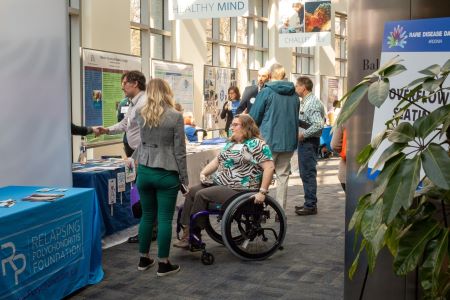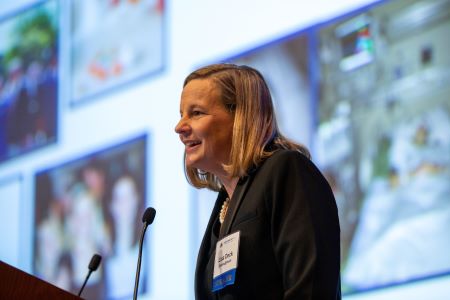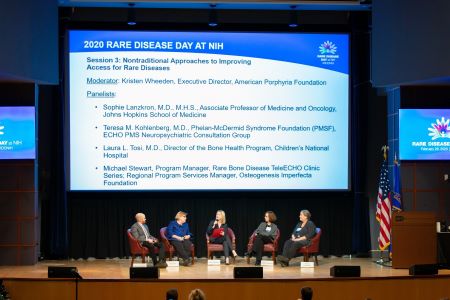Rare Disease Day at NIH: Drawing Hope and Building Connections Across the Community
May 1, 2020
Several years ago, Neena Nizar, Ed.D., read a sentence in a scientific article that would change her life forever. After years of corrective surgeries, Nizar finally had found hope in a hypothesis about a targeted molecular therapy for her rare genetic condition, which she had passed down to her two young sons. She underlined that sentence, cropped it from the article and moved her family from Dubai to the United States to pursue the possibility of treatment.
Nizar and her sons are part of a community of fewer than 30 people with Jansen’s metaphyseal chondrodysplasia, a condition that affects bone development. But the Nizar family is also part of a larger community — they are among the estimated 30 million people living with a rare disease in the United States. And although there are approximately 7,000 rare diseases, only about 5% have treatments approved by the U.S. Food and Drug Administration.
Nizar’s story was one of many shared at Rare Disease Day at NIH on Feb. 28, 2020. Co-sponsored by NCATS and the NIH Clinical Center, the annual event features rare diseases, the people they affect, and NIH research collaborations underway to address scientific challenges and advance new treatments.
Building New Connections
The Natcher Conference Center was abuzz with more than 700 patients, researchers, physicians and advocates. Among the crowd, a black-and-white pattern emerged: Like Nizar, who wore a zebra print scarf across her shoulders, many of the attendees donned shirts, skirts and accessories that featured zebra stripes. The zebra is a symbol for rare diseases in the United States; its distinctive stripes represent both the uniqueness of rare diseases and the commonalities among patients with rare diseases — two seemingly disparate attributes that epitomize the rare diseases community.

Amanda Proctor, President and CEO of the Cauda Equina Foundation, converses with a fellow attendee at Rare Disease Day at NIH. (NCATS)
Rare Disease Day at NIH provides an opportunity for patients, patient organizations, health care providers, regulators, researchers and others to forge connections, share stories and learn from one another.
“None of us can achieve our goal of understanding, diagnosing and treating rare diseases in a radically more efficient and effective way by ourselves,” said Christopher P. Austin, M.D., NCATS director. “We need each other.”
NCATS engages patients and patient organizations as essential partners in research. The NCATS Toolkit for Patient-Focused Therapy Development supports patient engagement in the research process with a collection of online resources that can help patient groups advance through the process of therapy development and provide them with the tools they need to advance medical research. The Rare Diseases Registry Program (RaDaR) is dedicated to improving the quality of patient registries by providing patient groups with guidance on how to develop registries for rare diseases. Good-quality registries can help communities better promote and support patient-focused research.
Shortening the Diagnostic Odyssey
Like Nizar, many people wait for years — or even a lifetime — to receive a correct diagnosis for their rare disease. Lisa Deck received an incorrect diagnosis of central nervous system vasculitis, a condition that leads to inflammation of the blood vessels. She underwent years of intensive chemotherapy after experiencing four strokes as a young adult. Finally, a neurointerventional radiologist identified the underlying cause of the strokes: moyamoya disease — a rare, progressive condition that leads to oxygen deprivation in the brain.
The phrase “diagnostic odyssey” often is used by people with rare diseases to describe the long path many of them take to receive an accurate diagnosis and is meant to evoke Odysseus’ harrowing 10-year journey home after the Trojan War. About 15% of patients with a rare disease wait for more than 5 years — often traveling to many specialists — to receive a diagnosis.
Deck’s diagnosis provided her with an answer to the debilitating symptoms that she had faced for most of her adult life. Although moyamoya does not yet have a cure, the diagnosis empowered Deck to research her condition and seek treatment. Furthermore, Deck has gained access to the knowledge and support of others who had undertaken similar medical journeys.

Lisa Deck shares her personal odyssey in pursuit of a diagnosis for the rare condition that she has faced for most of her adult life. (NCATS)
“I am so blessed that in those moments … I had so many people thinking about me, praying for me,” Deck recounted as she reflected on her brain surgeries. “So while I felt fear, while I felt worry, I also felt love. And that is part of the rare disease community.”
For many of these individuals, the answer lies within their DNA. About 80% of rare diseases are genetic, arising from a mutation within the genome.
Once an undertaking requiring 13 years and $2.7 billion to complete, sequencing and analyzing the human genome for diagnosis now takes about 50 hours. Richard A. Moscicki, M.D., chief medical officer and executive vice president of Science and Regulatory Advocacy, Pharmaceutical Research and Manufacturers of America, credited education and technological advancement for providing a path that previously was inaccessible.
“We are heading toward this end of the diagnostic journey,” Moscicki commented. “Thirty years ago, there was nothing like this discussion today. … I have great hope.”
Personalized Medicine: A New Therapeutic Approach
Rare diseases can challenge clinicians to develop unique solutions for treatment. Mila Makovec, a child with a rare form of Batten disease (an already-rare neurodegenerative condition), represents a case example of personalized medicine.
Once vivacious and outgoing, Mila was diagnosed with a condition that, by her mother’s account, was akin to “epilepsy, blindness, dementia, [and] Parkinson’s all combined in a little 6 year-old girl.” Julia Vitarello was told by doctors that her daughter’s condition was untreatable. However, she refused to give up. Vitarello shared Mila’s story through social media with a plea to the scientific community.
That plea reached Timothy W. Yu, M.D., Ph.D., a neurologist at Boston Children’s Hospital and Harvard Medical School. Using whole-genome sequencing, Yu uncovered Mila’s genetic mutation. His team developed a uniquely tailored drug to silence the effects of this mutation. In collaboration with the FDA, Mila became the sole participant in an expedited clinical trial.
“I still don’t know if [Mila’s treatment was developed] in time for her,” Vitarello said. “But I had so many parents reach out to me. … It just really hit me that this was more than Mila; it was more than my daughter. It was just a huge opportunity in this rare disease world where there are no tools in the toolbox.”
Mila’s treatment might help to slow the progression of her disorder, but her story carries a broader message of hope for other members of the rare diseases community. Advanced molecular tools enable an unprecedented approach for clinical researchers. Many disease communities are small, but personalized medicine may hold the potential to enable a large-scale movement across the field of biomedical research.
Empowering Physicians in the Rare Diseases World
Recent advances in biomedical research have offered the promise of rapid diagnoses and effective treatments to the rare diseases community. The next step, several attendees emphasized, is support and education for the physicians who encounter rare diseases in practice.

Panelists discuss nontraditional approaches to improving access for rare diseases, including Project ECHO®, at Rare Disease Day at NIH. From left to right: Michael Stewart; Laura Tosi, M.D.; Kristen Wheeden; Sophie Lanzkron, M.D., M.H.S.; and Teresa M. Kohlenberg, M.D. (NCATS)
Launched in 2003 through The University of New Mexico School of Medicine, Project ECHO® (Extension for Community Healthcare Outcomes) aims to empower health care providers by connecting them to a virtual network of support and education to address challenging medical cases in their local practices. Several speakers presented on their experiences with the program. Sophie Lanzkron, M.D., M.H.S., an associate professor of medicine and oncology at Johns Hopkins School of Medicine, explained that Project ECHO® uses telementoring to build relationships among providers around the world. Participants consult with an expert panel via videoconference to make decisions on diagnoses and treatment options for their patients.
“Most docs — like myself, a pediatric orthopedic surgeon — need to know about a lot of different rare diseases,” explained Laura L. Tosi, M.D., director of the Bone Health Program at the Children’s National Hospital. “It’s hard to keep everybody on the cutting edge. … [Project ECHO®] is giving us universal accessibility to folks across the globe.”
Reasons for Hope and a Call to Action
In his closing remarks, Austin reflected on the dual need for hope and action. “Hope,” he said, “is very important, but it’s not enough. You have heard time and time again that hope has to lead to action and action sustains hope.”
Nizar’s diagnosis led her to action. She founded The Jansen’s Foundation to promote awareness of and support research on Jansen’s disease. On her website, she writes, “We are on an incredible journey to find our miracle cure that will not only help our boys but bring hope to many others with rare skeletal diseases.”
The Jansen’s Foundation has been working closely with clinicians and researchers at Massachusetts General Hospital, who have recently entered into a collaboration with the Therapeutics for Rare and Neglected Diseases (TRND) program, an NCATS initiative to support the development of treatments for conditions that have been understudied. Nizar said that efforts to launch a clinical trial for Jansen’s disease are progressing through this collaboration. She credited the TRND program with enabling research for a small disease community that previously had been overlooked.
“Even a small disease like ours can find treatment,” Nizar said. “This isn’t a fairy tale; this isn’t some make-believe. It can happen.”



